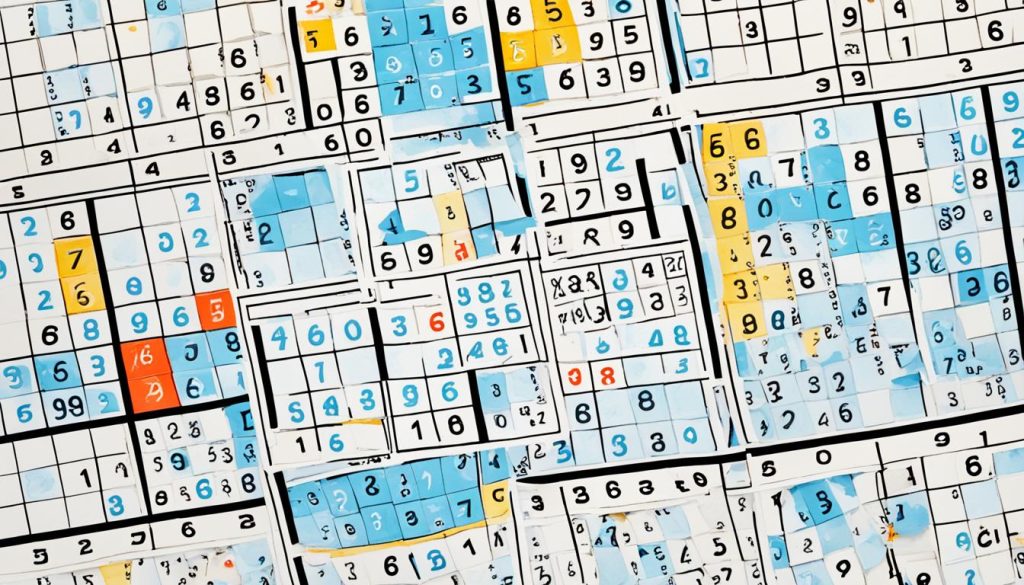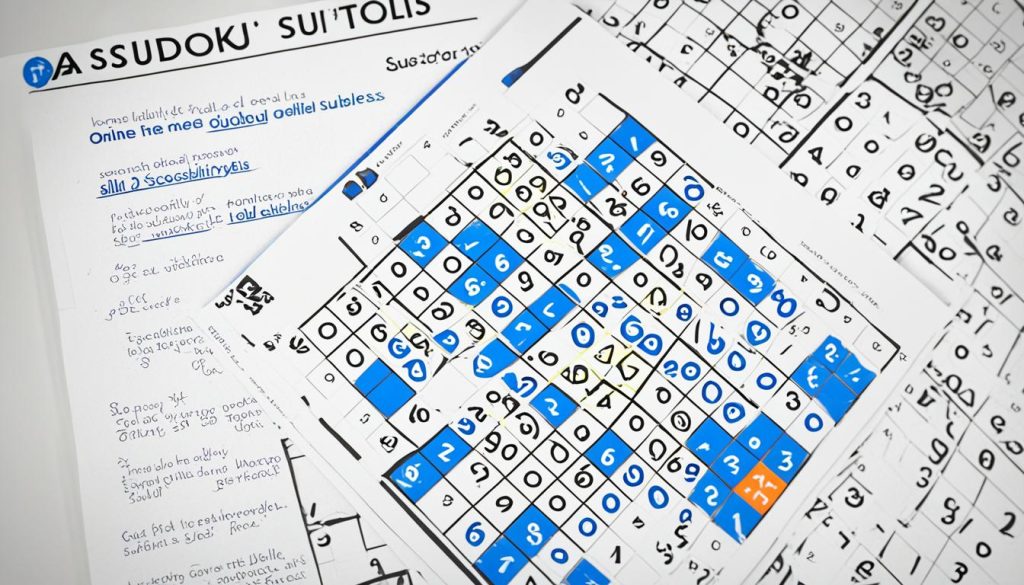Are you ready to embark on a delightful journey into the world of Sudoku? This captivating puzzle game has been entertaining and challenging people of all ages for years. If you’re a beginner looking to learn how to play Sudoku, then you’ve come to the right place. In this section, we’ll provide you with Sudoku advanced techniques and strategies that will set you on the path to becoming a Sudoku master.
How to Play Sudoku?
Here’s a step-by-step guide on how to play Sudoku:
- Understand the Rules: Sudoku is played on a 9×9 grid. The grid is divided into 3×3 subgrids called regions. The goal is to fill the grid so that each row, each column, and each region contains all the numbers from 1 to 9 without any repeats.
- Start with What’s Given: Begin by looking at the numbers already provided in the puzzle. These numbers will give you clues as to where you can start filling in the missing numbers.
- Focus on Rows and Columns: Look for rows or columns with the fewest missing numbers. It’s usually easier to figure out where a number goes when there are fewer options.
- Eliminate Possibilities: Use the process of elimination. Identify which numbers cannot go in a particular cell based on the numbers already present in the row, column, and region.
- Look for Unique Numbers: If a number can only fit in one particular cell within a row, column, or region, place it there.
- Use Logic: Sudoku is a game of logic, not guessing. Make logical deductions to solve the puzzle rather than randomly placing numbers.
- Keep Track of Options: Use small numbers (candidates) in the corner of cells to keep track of possible numbers that can go in that cell. This helps you remember the available options.
- Practice Regularly: Like any skill, practice improves your Sudoku-solving abilities. The more you play, the better you’ll become at spotting patterns and strategies.
- Be Patient: Sudoku requires patience and perseverance. Don’t get frustrated if you get stuck – take a break and come back to it later with fresh eyes.
- Enjoy the Challenge: Remember that Sudoku is a fun and challenging puzzle game that exercises your brain and logical thinking skills. Enjoy the process of solving each puzzle!
Sudoku Rules
The rules of Sudoku are straightforward and essential to follow to solve the puzzle correctly. Here are the basic rules of Sudoku:
- The Grid: A standard Sudoku puzzle consists of a 9×9 grid, divided into nine 3×3 subgrids called regions.
- Numbers: The objective is to fill the grid with numbers ranging from 1 to 9. Each row, column, and region must contain all numbers from 1 to 9 without any repeats.
- No Repeats: No number can be repeated within a row, column, or region. Each number can appear only once in each of these areas.
- Initial Numbers: At the start of the puzzle, some numbers are provided as clues. These are referred to as “given” or “initial” numbers.
- Logic: Solving Sudoku requires logic and reasoning. Guessing should be avoided, as there is always a logical path to solving the puzzle without trial and error.
- One Solution: Each Sudoku puzzle has only one valid solution. The solution is unique, and every number you place contributes to reaching that single correct solution.
- Consistency: Consistency is key when solving Sudoku. Ensure that each number placement adheres to the rules of the game without contradictions.
By following these rules and applying logical thinking, you can successfully solve Sudoku puzzles. Enjoy the challenge and have fun exercising your problem-solving skills!
Beginner Strategies for Sudoku
For beginners looking to improve their Sudoku skills, there are several effective strategies to consider. By employing these tips, new players can enhance their problem-solving abilities and solve Sudoku puzzles more efficiently. Let’s explore some beginner-friendly strategies below:
Crosshatching
One helpful strategy is crosshatching, which involves focusing on each square in the grid and identifying missing numbers. By analyzing the information from rows and columns, players can narrow down the possible solutions for each square. This method helps in eliminating incorrect choices and arriving at the correct answers.
Counting
Counting is another useful tactic for beginners. It involves identifying partially filled rows or columns and using the available information to deduce potential candidates for empty cells. By analyzing the numbers already present, players can determine which numbers are missing and make logical deductions to fill in the blanks confidently.
Naked and Hidden Singles
Two additional strategies that beginners should be familiar with are naked singles and hidden singles. Naked singles refer to squares with only one remaining possible number. By identifying these squares, players can confidently fill in the correct number. Hidden singles, on the other hand, are numbers that only fit in one specific square within a row, column, or box. Recognizing and utilizing hidden singles can help beginners progress through the puzzle more efficiently.
Naked and Hidden Pairs
Beyond the basics, the strategies of naked pairs and hidden pairs can provide beginners with additional tools to conquer Sudoku puzzles. Naked pairs occur when two numbers appear as the only possibilities in two different squares within the same row, column, or box. In such cases, these numbers can be eliminated as possibilities from other squares in the same row, column, or box. Hidden pairs involve identifying two numbers that can only fit in two squares within a row, column, or box, eliminating those numbers as possibilities from other squares. Employing these strategies can help beginners gain an edge in solving Sudoku puzzles.
By implementing these beginner strategies, players can develop a stronger foundation for solving Sudoku puzzles and gradually improve their skills. With practice and perseverance, beginners can successfully solve more challenging puzzles and become confident Sudoku enthusiasts.

Sudoku Advanced Techniques
Once beginners have grasped the basic strategies of Sudoku, they can elevate their game by delving into Sudoku advanced techniques. These advanced Sudoku advanced techniques provide players with the tools to tackle more challenging puzzles and boost their problem-solving abilities.
One such technique is the X-Wing method. This method involves identifying patterns in rows and columns to eliminate possibilities and determine the correct placement for numbers. By recognizing the X-Wing pattern, players can eliminate candidate numbers and narrow down the solution possibilities, simplifying the puzzle.
Another advanced technique is known as pencilmarking. This technique allows players to analyze multiple possibilities for each cell by marking potential candidate numbers. By carefully considering the relationships between cells and using logical reasoning, players can deduce and narrow down the correct number placement for each cell. Pencilmarking helps players maintain a systematic approach and reduces confusion during puzzle-solving.
By honing these advanced Sudoku advanced techniques, players can confidently tackle more complex puzzles. These techniques provide a deeper understanding of puzzle structures and improve logical thinking skills, ensuring a more enjoyable and rewarding Sudoku experience for players at any level.
To summarize:
- The X-Wing method involves pattern recognition in rows and columns to eliminate possibilities and find the correct number placements.
- Pencilmarking allows players to analyze multiple possibilities for each cell, leading to more systematic puzzle-solving.
With Sudoku advanced techniques in their repertoire, players can enhance their Sudoku skills and take on even the most challenging puzzles with confidence.
| Advanced Sudoku Techniques | Description |
|---|---|
| X-Wing Method | The X-Wing method involves identifying patterns in rows and columns to eliminate possibilities and find the correct number placements. |
| Pencilmarking | Pencilmarking allows players to analyze multiple possibilities for each cell, leading to more systematic puzzle-solving. |

Online Resources for Sudoku
For beginners looking to enhance their Sudoku skills, there are several online resources available. These resources provide a convenient way for beginners to learn and practice Sudoku at their own pace.
Online Tutorials and Video Guides
Online tutorials and video guides are valuable tools for beginners. They offer step-by-step instructions for solving Sudoku puzzles and provide helpful tips and tricks. These tutorials cover various aspects of Sudoku, from understanding the rules to implementing strategies. Beginners can follow along and learn at their own pace, gaining confidence in their abilities.
Additionally, video guides provide visual demonstrations of solving Sudoku puzzles, making it easier for beginners to grasp the concepts and techniques. Having someone walk through the process and explain each step can be incredibly beneficial, especially for those who prefer visual learning.
Websites and Mobile Apps
In addition to tutorials and video guides, there are websites and mobile apps dedicated to Sudoku. These platforms offer a wide range of Sudoku puzzles, catering to different difficulty levels, including puzzles specifically designed for beginners.
Websites provide an online platform where beginners can access Sudoku puzzles anytime, anywhere, and solve them directly on the website. Some websites offer features that allow players to track their progress, compete with others, or even create custom puzzles.
Mobile apps provide a convenient way to play Sudoku on smartphones or tablets. These apps often offer interactive interfaces and user-friendly features, making it enjoyable for beginners to practice and improve their skills on the go.
Whether using websites or mobile apps, beginners can find Sudoku puzzles tailored to their level, ensuring a gradual progression and an optimal learning experience.
| Online Resources | Description |
|---|---|
| Online Tutorials and Video Guides | Step-by-step instructions and visual demonstrations for solving Sudoku puzzles, offering tips and tricks. |
| Websites and Mobile Apps | Platforms that provide various levels of Sudoku puzzles, accessible online or through mobile devices. |
These online resources offer a wealth of knowledge and practice opportunities for beginners. With diligent learning and consistent practice, beginners can quickly improve their Sudoku skills and progress to more challenging puzzles.

Conclusion
Sudoku is a challenging and rewarding puzzle game that provides endless hours of entertainment. Whether you’re a beginner or an experienced player, mastering the game is within reach. By applying the tips and strategies discussed in this guide, beginners can approach Sudoku puzzles with confidence and improve their solving skills.
Remember, practice is key. As you continue to solve Sudoku puzzles, you’ll develop a game deeper understanding of the game and refine your tactics. Embrace the process and don’t get discouraged by difficult puzzles. With patience and perseverance, you can become a master of the game.
Advanced Sudoku techniques, such as the X-Wing method and pencilmarking, can take your skills to the next level. These techniques allow you to solve more complex puzzles and tackle even the most challenging grids. By incorporating these strategies into your gameplay, you’ll be able to solve Sudoku puzzles with efficiency and accuracy.
FAQ
How to Solve Sudoku for Beginners?
Solving sudoku for beginners can seem like a daunting task, but with practice and the right strategies, you’ll be completing even the most challenging puzzles in no time. First, start by familiarizing yourself with the basic rules of sudoku: each row, column, and 3×3 box must contain the numbers 1-9 without any repeats. Next, begin filling in easy cells that have only a few options. From there, use logic and elimination to fill in more difficult cells. If you get stuck, don’t be afraid to use pencil marks or hints to guide you towards the solution.
Is Sudoku a Math or Logic?
Sudoku may involve numbers, but it is primarily a logic game. The goal of Sudoku is not to solve complex equations, but to use logic and critical thinking skills to fill in the empty spaces on the grid with numbers.
What is the logic of Sudoku?
The logic of Sudoku is based on the simple rules of using only numbers 1-9, with no repeats in any row, column, or 3×3 square. Each puzzle starts with a few numbers already given as clues and it’s up to you to use deductive reasoning and problem-solving skills to fill in the remaining numbers. This addictive game has been proven to improve memory and critical thinking skills while providing a fun challenge for players of all ages.
Is Sudoku good for IQ?
Absolutely! Sudoku is not only a fun and challenging game, but it also has numerous benefits for your brain. Studies have shown that regularly playing sudoku can improve memory, concentration, critical thinking skills, and overall cognitive function. It’s like a workout for your brain, helping to keep it sharp and agile.






